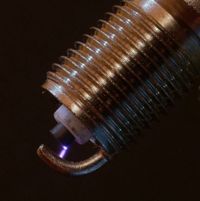
Photo from wikipedia
Low-cost particulate matter (PM) sensors provide new methods for monitoring occupational exposure to hazardous substances, such as flour dust. These devices have many possible benefits, but much remains unknown about… Click to show full abstract
Low-cost particulate matter (PM) sensors provide new methods for monitoring occupational exposure to hazardous substances, such as flour dust. These devices have many possible benefits, but much remains unknown about their performance for different exposure monitoring strategies in the workplace. We explored the performance of PM sensors for four different monitoring strategies (time-weighted average and high time resolution, each quantitative and semi-quantitative) for assessing occupational exposure using low-cost PM sensors in a field study in the industrial bakery sector. Measurements were collected using four types of sensor (PATS+, Isensit, Airbeam2, and Munisense) and two reference devices (respirable gravimetric samplers and an established time-resolved device) at two large-scale bakeries, spread over 11 participants and 6 measurement days. Average PM2.5 concentrations of the low-cost sensors were compared with gravimetric respirable concentrations for 8-h shift periods and 1-min PM2.5 concentrations of the low-cost sensors were compared with time-resolved PM2.5 data from the reference device (quantitative monitoring strategy). Low-cost sensors were also ranked in terms of exposure for 8-h shifts and for 15-min periods with a shift (semi-quantitative monitoring strategy). Environmental factors and methodological variables, which can affect sensor performance, were investigated. Semi-quantitative monitoring strategies only showed more accurate results compared with quantitative strategies when these were based on shift-average exposures. The main factors that influenced sensor performance were the type of placement (positioning the devices stationary versus personal) and the company or workstation where measurements were collected. Together, these findings provide an overview of common strengths and drawbacks of low-cost sensors and different ways these can be applied in the workplace. This can be used as a starting point for further investigations and the development of guidance documents and data analysis methods.
Journal Title: Annals of work exposures and health
Year Published: 2023
Link to full text (if available)
Share on Social Media: Sign Up to like & get
recommendations!